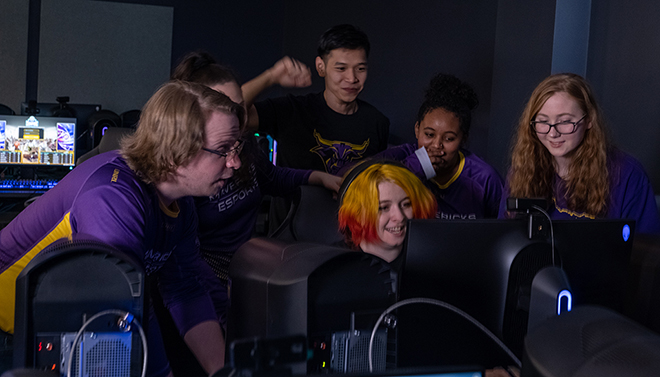Minnesota State University, Mankato junior Bill Pascual is like countless other student athletes at the University: He juggles classes, homework and practice throughout the week, working with his coach and his teammates to strengthen their chances for placing well in the team’s next competition.
Pascual is part of the University’s newly formed esports program, and while the sports arena may look a little untraditional, the game play is just as focused and fierce.
“We’re still students, and we still have to keep our responsibilities of being those students and keeping our grades up,” he explained. “That will take first priority. Secondary priority is toward the team. The obvious goal is just to win.”

According to program director Mitch Wallerstedt, the University’s esports program was student-focused from the start. Several student organizations, such as Maverick League of Legends and the Maverick CSGO Club, already offered students the chance to competitively game, with members even organizing tournaments on campus. These organizations approached the University administration in 2019 to ask for more formal support.
“We really started from that grassroots perspective, working with the students, asking how we could help them from an institutional perspective to recognize both the work they were doing and help organizationally,” Wallerstedt said. “We started building off the effort they were doing and keeping that student focus but elevating it and giving it a bigger platform.”
The process went quickly, with a varsity program organized by spring 2020. While COVID-19 threw a snag into the timeline, the fledgling team was still able to get off the ground thanks to its online nature. University alum Jacquie Lamm was tapped to become the team’s first head coach, and the varsity team became part of the National Association of Collegiate Esports (NACE).
The University also unveiled a new esports training facility in October 2020, working with sponsors Dell and Alienware.
The training facility has 20 PCs, eight Alienware machines, Alienware peripherals, a broadcasting system and a review room for players to watch recordings of previous performances.
During the program’s first year, it already had four game titles for players to compete in, and three of the varsity teams made the playoffs in national championships.
“I think we outdid our expectations [for the first year],” Lamm said. “This coming year, we’ve got a great lineup, so I’m excited to see what they can do.”
Lamm added that the plan is to have 10 game titles and 70 to 80 varsity students for fall 2021. She said they draw most of their players from current students, but they do have 30 to 40 incoming first-year students who are coming to the University to play on the varsity team. There are also plans to start an esports learning community on campus this fall.
While esports are still an unfamiliar arena for many people, Wallerstedt said competitive gaming teaches student athletes the same things as other, traditional sports.
“Just like in any other competitive activity, you’re looking at how [to] build teamwork, communication and leadership skills,” he said. “That’s really an important part of what we’re looking at with our different titles—how can we help build those skills through this competitive environment with the students?”
For Pascual, that teamwork is one of the most important parts of why he plays the game.
“[Esports] gives the opportunity for students who … play video games to have a community that plays the same games,” he said. “We’re not just teammates—we’re friends.”
Speak Your Mind